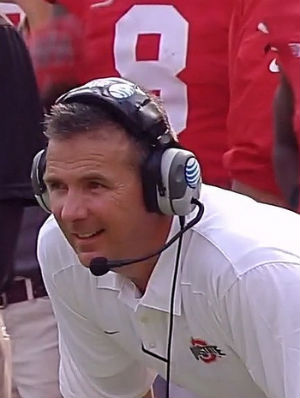
Extra points are no longer an afterthought for the Ohio State Buckeyes.
In 2013, Urban Meyer has shown a willingness to play around with the traditional point after touchdown. Rather than just lining up in the obligatory field goal formation and kicking every time, the Buckeyes have borrowed some of Chip Kelly’s “swinging gate” principles (the Buckeyes call it the “Aztec” formation) and a variety of plays that can turn one point into two.
“So they have to work on the field goal and they have to work on this Aztec formation,” Urban Meyer said.
Ohio State was successful twice on two-point tries in the opener against Buffalo. But a conversion attempt against Florida A&M this past Saturday went unrewarded — when Jordan Hall was stuffed after catching a pass.
Is all this two-point trickeration a good thing? I submit that it is.
While an additional point may not come into play against the likes of Buffalo or FAMU, it might make the difference between overtime or victory in, say, a night road game in Evanston.
One thing the swinging gate formation does is force the other team to react. If the opponent doesn’t respond properly, it creates an exploitable mismatch and potentially an easy additional point. It’s never a bad idea to put more points on the board.
Running these kinds of plays forces opposing teams to spend valuable practice time on figuring out how to stop them. While teams spend valuable time trying to diagnose the conversion in the film room and in special teams meetings, Ohio State’s staff can add new wrinkles or completely leave two-pointers out of the game plan. That means the other team has just effectively wasted some of its preparation time.
 Master of trolling the opposition.
Master of trolling the opposition.On the field, a tendency of going for two creates uncertainty for the defense. They waste time during the play watching for the two-point try and it gives Drew Basil extra time to boot the ball when it is a standard PAT. That uncertainty, or “putting the other team on its heels” is a staple of Urban Meyer’s offensive philosophy, which apparently has bled over into special teams play.
Finally, if Ohio State finds itself in a situation where it must go for two, game reps will provide the confidence that leads to success. The same principle of getting players comfortable going for it on fourth down applies to two-point conversions. If the situation is deemed “normal,” there shouldn’t be any of the nervousness that can ruin execution.
In addition to the above reasons, it also raises the excitement level. As a Buckeye fan, it’s nice to watch Basil tack on the extra point. But it’s better still to see Jordan Hall or Philly Brown get into the end zone to turn six points into eight. Meyer puts a lot of thought into ways to get cheap points and make his opposition work at every aspect of their preparation.
“There's a lot of reasons to do it,” Meyer said. “One is to get a big hit, which is we did, and the other is just to drive them nuts as far as what they have to prepare for. It's a pain in the rear end.”
About the only drawback to going for two repeatedly is that if a team really needs a two-pointer to tie or win a game later in the season, they’ve already tipped their hand with what kind of plays it likes to run and potentially has already used its best play. So it behooves a team to hold back its best two-point play in special glass box, which should only been broken in case of emergency.
Is going for two when unnecessary just showing off? Is it unsportsmanlike? Or is it another way to put pressure on the opposition? Maybe it’s all three. Whatever it is, Ohio State is doing it, and, if teams can’t stop it, that probably won’t change.

